

The Art of Customer Delight. A version of this article appeared in the Spring 2017 issue of strategy+business.
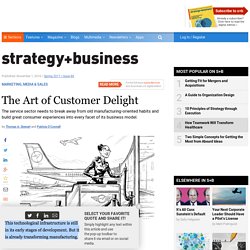
Airlines routinely rank near the bottom of customer satisfaction surveys. But we would wager that most customers, like us, find that the time on the plane — the “sit back, relax, and enjoy the flight” part — is the least awful piece of their experience. The nightmare is everything else: prices that change from minute to minute and bear no perceivable relationship to actual cost or value, fees for checking bags and just about any amenity, and frequent delays caused by weather or “the late arrival of the incoming aircraft.” Airports themselves have their own set of annoyances: check-in kiosks that are out of order or can’t read your credit card, the queues and indignities of security, inadequate staffing; seemingly random gate-change announcements, and the scrum at the gate.
Welcome to Surf Air, which sells flights by subscription. Service Design Is a Bridge Consider how Surf Air designs its service. 1. 2. 3. How to Deliver Moments of Magnificence to Your Customers! - Rick Conlow. Few people talk about receiving outstanding service.
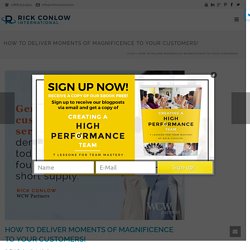
Few companies deliver what I call Moments of Magnificence to customers. It shouldn’t be that way. It doesn’t have to be that way. The State of Customer Service in the Marketplace. How The Connected Customer Will Impact Your Business. When It Comes to Trust, It’s the Little Things. Early in my career I helped manage part of the main selling floor at Bloomingdale’s Manhattan flagship department store.
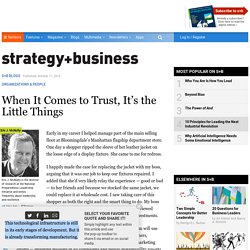
One day a shopper ripped the sleeve of her leather jacket on the loose edge of a display fixture. She came to me for redress. I happily made the case for replacing the jacket with my boss, arguing that it was our job to keep our fixtures repaired. I added that she’d very likely relay the experience — good or bad — to her friends and because we stocked the same jacket, we could replace it at wholesale cost. I saw taking care of this shopper as both the right and the smart thing to do. When consumers trust your brand, overwhelming numbers of them will use your products and services frequently and recommend them to others, research shows.
But what if the key is instead to sweat the small stuff? Kick-Ass Customer Service. Think about the last time you flew.

When you checked in, did you use a self-service option—like the airline’s website, app, or airport kiosk—to check your bags, choose your seat, and print out your boarding pass? Or did you instead wait in line at the airport to speak with a human being? If you’re like most people, you used the self-service option. Indeed, our data show an overwhelming preference for self-service: Across industries, fully 81% of all customers attempt to take care of matters themselves before reaching out to a live representative. Self-service offers companies a tantalizing opportunity to reduce spending, often drastically. All this creates a new challenge: As customers handle more of the simple issues themselves, frontline service reps get increasingly tough ones—the issues customers can’t solve on their own.
Compounding the issue, as companies have focused on new self-service technologies, they’ve underinvested in frontline service talent. Become a 'Follow Up Guru' and Watch Your Business Boom. Start Your Customer Surveys by Asking What Went Right. Kenneth Andersson Most organizations use customer surveys to measure satisfaction, pinpoint areas for improvement, or simply allow disgruntled patrons to vent.

The approach is framed by a pessimistic mindset—one focused on problems. “Customers have been conditioned to always look for what’s wrong,” says Sterling Bone, an associate marketing professor at Utah State’s Huntsman School of Business. Indeed, the vast majority of research on customer service deals with “service recovery”—how to react when a customer complains. During a Bible study course nearly a decade ago, Bone found himself reflecting on the power of gratitude, and he began wondering what would happen if that emotion was incorporated into customer surveys.
Since then Bone and colleagues have conducted research to explore the idea. The researchers offer several possible explanations for these results. Customer Loyalty Isn’t What It Used to Be. It’s getting harder to build and maintain customer loyalty.
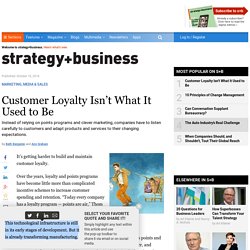
Over the years, loyalty and points programs have become little more than complicated incentive schemes to increase customer spending and retention. “Today every company has a loyalty program — points are air,” Thom Kozik, vice president of loyalty at Marriott International, recalled at a recent industry conference. Indeed, studies across a number of industries indicate that today’s points and perks programs do little to differentiate one company from another, and appear to influence loyalty and future purchasing behavior far less than they used to. When It Comes to Trust, It’s the Little Things. Early in my career I helped manage part of the main selling floor at Bloomingdale’s Manhattan flagship department store.
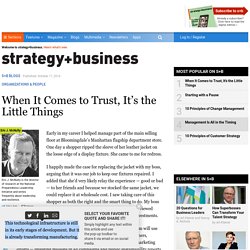
One day a shopper ripped the sleeve of her leather jacket on the loose edge of a display fixture. She came to me for redress. I happily made the case for replacing the jacket with my boss, arguing that it was our job to keep our fixtures repaired. I added that she’d very likely relay the experience — good or bad — to her friends and because we stocked the same jacket, we could replace it at wholesale cost. I saw taking care of this shopper as both the right and the smart thing to do. When consumers trust your brand, overwhelming numbers of them will use your products and services frequently and recommend them to others, research shows. How Not To Engage Employees: Telecoms Lead The Way Again. Businessinsider. It’s been said that there are 87,000 ways to order a drink at Starbucks.

You’ve got your non-fat milk, full-fat milk, soy milk, and coconut milk; espresso shots; all the different flavored syrups, some of which are sugar-free; whipped cream; iced, hot, or “extra hot” if you’ve got a Kevlar tongue; different sizes; different roasts of coffee; and on and on and on. Surely some of those combinations are gross—Venti green tea latte with peppermint and whipped cream, anyone? How-to-lose-a-customer-in-one-day. Conventional: Do more with less On the Contrary: Don't ask people to pay more for less If you've taken an airport shuttle in the last five years, you know firsthand what's wrong with reclassifying low-wage workers as franchisees or contracts: The quality of the service goes to hell.
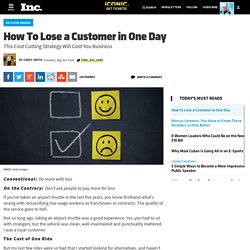
Not so long ago, taking an airport shuttle was a good experience. Yes, you had to sit with strangers, but the vehicle was clean, well-maintained and punctuality mattered. I was a loyal customer. The Cost of One Ride But my last few rides were so bad that I started looking for alternatives, and haven't scheduled a shuttle pick-up since. The answer was a broken strategy, one with no room for accountability: The shuttle driver was not, in fact, an employee of the shuttle company. 5 Things You Absolutely Need to Include When Following Up on a Customer Complaint. In last week’s blog post, I talked about what to do when you encounter an upset customer.

The L.A.F.T. system works wonders in recovering guests after an unpleasant experience. 4 Steps to Recovering an Upset Customer. In the first three chapters of our Playbook, we discussed why customer feedback is so important, how to write questions to get the best feedback, and how to offer incentives and raise awareness to ensure that your customers know about your survey and want to take it. But there’s another step in the process that we haven’t yet addressed. What do you do when you receive negative customer feedback? It is inevitable that some customers will request contact after a poor experience. Actually, allowing customers to request contact is a key component of any successful feedback program. We call it customer recovery. Busy-is-no-excuse-for-poor-customer-service. Most business owners and other entrepreneurs know that customer service is important, but they may not realize just how important.
Building your business's reputation starts with customer service and ends with an amazing product or service. But, you have to get through step one before you can show your customer how great your product or service really is. Take a few lessons from one of the worst customer service experiences of my life (so far) to avoid angry customers and acquire repeat customers. Shortly after I moved into my house a few years ago I hired a painter.
Everything he told me upfront sounded great, but as the job progressed, I realized that this painter was awful--rude, inconsiderate, unreliable, and terrible at managing his company. By the end of the project, things were so bad that while we wanted his crew to finish the job, we asked him not to come back. How Your Leadership Focus Drives The Customer Experience. 3 Rules for Customer Feedback. Gathering useful timely feedback from customers can be a long process. Intercom makes it faster and easier than ever before but just because it’s now easy to ask it doesn’t mean it’s a good idea to waste your customers’ time. Answering a question well is always tougher than asking it. 4 Steps From Customer Anger To Customer Loyalty. The Cost of Customer Service Wait Times (Infographic)
Paris Considers Friendlier Service The New Battleground For Tourism Dollars. Recognize Your Customers If You Want Their Trust. The Customer Service Habit: Why Your Company Culture Needs To Catch It. Every Mistake is An Opportunity to Surprise and Delight.